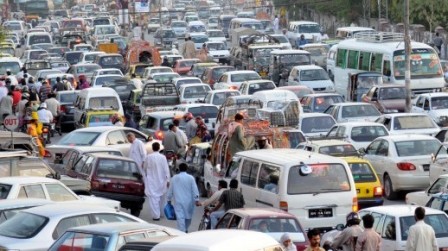Pakistan's Air Pollution Crisis
Motorcycles, despite being a smaller category of vehicles, are identified as the primary culprits. The establishment of an inspection and control system and the need for international assistance in pollution monitoring are emphasized to tackle the air pollution challenge effectively.

ISLAMABAD 10/23/2023: In our ongoing series, we're diving deeper into Pakistan's air pollution challenges, with a specific focus on the significant contribution of vehicles to this issue. We'll also explore public policy measures to control pollution and pave the way for a cleaner, healthier future. This discussion not only impacts the environment but also has implications for the Pakistan Economy, Business in Pakistan, and Technology in Pakistan.

Picture Courtesy: The Express Tribune
Interpreting air pollution data in Lahore can take us in two opposite directions. On the one hand, 32% of the time (or 186 days per year), air quality is within satisfactory limits. On the other hand, air pollution has been unsatisfactory for 68% of the time, signaling a pressing issue.
Transport's Role in Air Pollution:
Globally, the transport sector contributes between 20% and 70% of air pollution, depending on several factors. In Lahore, the transport sector is responsible for 40% of total air pollution. What's surprising is that nearly 69% of this pollution originates from motorcycles.
Motorcycles emit more pollutants than cars
Rising Vehicle Population:
The number of vehicles on the roads is steadily increasing, particularly in Lahore and across Punjab. In Lahore, vehicle population has surged from 2.39 million in 2011 to 6.29 million in 2021, with motorcycles accounting for 4.8 million, and the rest comprising cars, trucks, and buses.
The Motorcycle Mystery:
While it might seem like motorcycles produce less pollution, that's not entirely accurate. Due to limitations in space and budget in developing countries like Pakistan, motorcycles haven't embraced advanced pollution control technologies like cars. As a result, motorcycles emit more pollutants than cars, including 13% more CO2, 36% more NOx, and a staggering 335% more hydrocarbons.
Policy Measures to Combat Air Pollution:
To tackle transport-based air pollution, several guidelines have been adopted, including:
1. Early retirement of older vehicles through laws or incentives.
2. Raising awareness about proper vehicle maintenance.
3. Prescribing and monitoring vehicle emission limits and laws.
4. Improving fuel quality (shifting from Euro 1-2 to Euro 5-6 standards).
5. Transitioning to cleaner fuels (CNG, ethanol blends, and electric vehicles).
6. Boosting railway traffic, especially for freight.
7. Promoting public transport and carpooling.
8. Implementing green town planning and relocating industrial zones outside the city.
9. Establishing low-pollution zones.
Pakistan has made strides in implementing these guidelines, such as mandating the import of Euro-5 petrol and diesel. New clean-fuel refineries are in the pipeline. Electric vehicles (EVs) are also gaining traction, with a policy in place for 30% of locally produced motorbikes to be EVs.
Inspection and Control (I&C) System:
An I&C system, similar to those in industrialized countries, is crucial. This system should include:
1. Setting emission limits for different vehicle types.
2. Enforcing these laws through legal measures.
3. Establishing vehicle emission inspection centers.
4. Defining inspection frequencies and standards.
5. Creating an emission database.
6. Auditing the performance of I&C centers.
Pakistan has already taken steps to implement some of these guidelines. The mandatory import of Euro-5 petrol and diesel is in place, although local refineries still predominantly produce Euro-2 grade fuel. There are plans to upgrade older refineries and build new, clean-fuel refineries. To address air quality concerns in places like Lahore and Faisalabad, imported fuel should be exclusively distributed.
Electric vehicles (EVs) are gaining attention as a cleaner alternative to motorcycles in Southeast Asia. While Pakistan may not immediately transition to 100% EVs due to economic constraints, an EV policy has been introduced, with the goal of making 30% of locally produced motorbikes electric. Several EV motorbike manufacturing companies have already set up shop, with more seeking licenses to do so. The gradual replacement of petrol bikes with EVs in pollution-sensitive areas is under consideration.
A comprehensive inspection and control (I&C) system is crucial. Many developed and developing countries have established such systems, including India, Malaysia, and Indonesia. Pakistan should consider introducing an I&C system. This could begin voluntarily and offer free services. The I&C system comprises several steps, including setting emission limits for different vehicle types, establishing a legal framework for enforcement, and creating inspection centers equipped with the necessary technology. The introduction of mobile drive-by emission inspection systems can help identify gross violators.
Given the dominance of motorcycles in the transport sector's contribution to air pollution, it is essential to prioritize measures that specifically target motorcycles. Seeking international technical assistance for the establishment of a comprehensive pollution monitoring system, both for Air Quality Index (AQI) and vehicle emissions, is crucial. Monitoring alone is insufficient; corrective actions should be introduced through public-private partnerships. Ultimately, the transition to EVs, particularly for motorcycles, holds the key to a cleaner and healthier environment.


 The Express Tribune
The Express Tribune 





